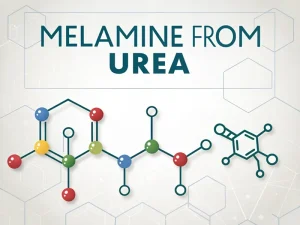
Melamine Packaging
Tech Blog Melamine packaging For manufacturers, inaccurate packaging not only fails to meet national standards but also increases labor costs and the risk of product


Melamine powder (C₃H₆N₆) is a nitrogen-rich organic compound widely used in industrial and consumer goods, from durable tableware to flame-retardant materials. Understanding its molar mass is crucial for chemical synthesis and quality control.
This article explores how the molar mass of melamine is calculated, its significance in industrial applications, and its role in both beneficial and problematic environments.
Molar mass (also known as molecular weight) is the mass of one mole of a substance, expressed in grams per mole (g/mol). It is calculated by adding the atomic masses of all atoms in the molecule.
The molecular formula of melamine is C₃H₆N₆, consisting of the following parts:
3 carbon (C) atoms
6 hydrogen (H) atoms
6 nitrogen (N) atoms
Using the standard atomic mass in the periodic table:
Carbon (C): 12.011 g/mol x 3=36.033 g/m
Hydrogen (H): 1.008 g/mol x 6=6.048 g/m
Nitrogen (N): 14.007 g/mol x 6=84.042 g/m
Total molar mass = 36.033 + 6.048 + 84.042 = 126.123 g/m
Melamine formaldehyde resin:
The molar mass determines the stoichiometric ratio of the reaction between melamine and formaldehyde.
Example: To produce 1 mole of resin, 1 mole of melamine (126.14 grams) is reacted with 3-6 moles of formaldehyde.
Flame retardant
The high nitrogen content of melamine (driven by its molar mass) makes it an effective flame retardant. When heated, 3 moles of nitrogen (N ₂) are released per mole of melamine, diluting oxygen and suppressing combustion. Quantify this characteristic using its molar mass to determine the optimal additive concentration.
Adhesive and coating applications
The molar mass of melamine oligomers in wood adhesives affects the depth of penetration of the adhesive into wood fibers. Low molecular weight oligomers may provide better permeability but weaker long-term binding, while higher molecular weight variants provide stronger binding but reduced flow.
Regulatory restrictions (such as the US Food and Drug Administration’s requirement of 2.5mg/kg melamine migration in tableware) require precise molar mass testing.
The molar mass affects the absorption, distribution, and excretion of melamine in the human body. Smaller molecules (such as urea) are easier to metabolize. Still, the structure of melamine (with a molar mass of approximately 126 g/mol) allows it to form insoluble complexes with cyanuric acid, leading to regulatory restrictions on kidney stone formation.
The molar mass of melamine affects its solubility and fluidity in ecosystems. Its solubility in water is relatively low (3.1 g/L at 20 °C), and its molecular size is moderate, which contributes to its persistence in soil and water, where it can bioaccumulate in aquatic organisms.
As the industry continues to rely on melamine, understanding its molar mass and related risks is crucial for promoting safe and sustainable practices. By utilizing this knowledge, we can better utilize melamine.

Tech Blog Melamine packaging For manufacturers, inaccurate packaging not only fails to meet national standards but also increases labor costs and the risk of product

Tech Blog How to Detect Melamine in Textiles? Melamine powder, a nitrogen-containing heterocyclic compound, is widely used in flame-retardant textiles and plastic products due to

Tech Blog melamine from urea Melamine is well-known for its wide range of applications, but its raw material for production is surprisingly urea. For manufacturers,

JINGJIANG MELAMINE POWDER
© JINJIANG MELAMINE